It was a true revelation to experience the action at the High Island rookery a couple weeks ago, and it was all fueled by the “Big Pink Birds” that dominated my attention there. During and after that afternoon session of photographing Roseate Spoonbills, I realized they yielded a power that made me want more – more pink flights, more pink photos, more pink birds, more pink power. I might better describe pink ‘power’ as one of the natural energies we birders get from certain birds that provide a level of euphoria and elevated energy levels. It’s different for each birder as to which birds provide that power, and it can change with time. But for now – big pink birds are hard to beat for me, and the feeling was pretty universal among other birders and other interested people who visited the elevated Canopy Walkway.
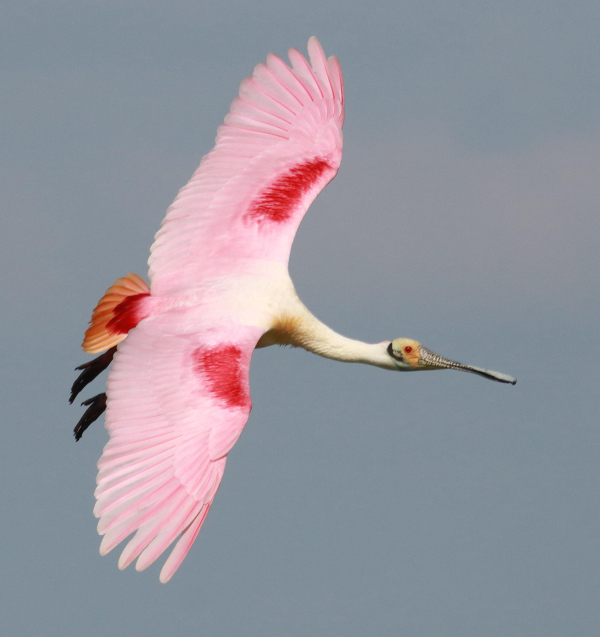
Pink power at its best as a spoonbill banks into the sun on a beautiful spring afternoon.
Of course, to call the color of these birds “pink” is almost derogatory, as “roseate” far better describes the beautiful hues of pink that vary from scarlet red to pink-white. Realistically, while their plumage has exceptional coloration, the rest of the bird is not very attractive, unless you’re a spoonbill I guess. With a bare green-and-yellow head dotted with red eyes, and a long gray bill with a most-unusual flattened, circular spatulate end adults are quite unusual. Their bright red legs and feet augment the pink plumage, but they seem unusually oversized and stout compared to other wading birds. In short they are beauty and the beast all in one package, but in flight, they are elegant and attract the immediate attention of any people around them.
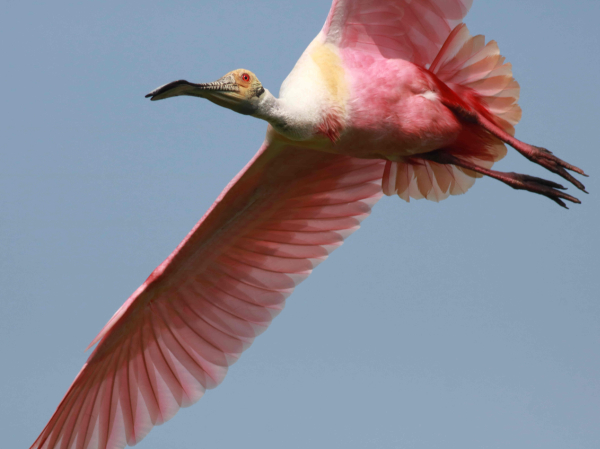
Testing the close-focus qualities of the telephoto lens and quick reflexes of the photographer, another banking Roseate Spoonbill provides a dramatic photo angle.
When I returned to the Smith Oaks Rookery last Friday, 15 days had passed since my first visit, so the scene and the mix of birds changed as the nesting season progressed. Many more Snowy Egrets and more Tricolored Herons were present, all in the beginning throws of the nesting period, with much calling, displaying and pairing, establishing and defending territories and nest sites, and beginning to collect the all-important twigs to build their nests, with many more pairs to follow. Snowys might be the second most populous birds at the rookery now, second to Great Egrets that seemed to be running the gamut of the nesting cycle from displaying and pairing, to nest building, egg laying, incubating, and feeding young nestlings in a few cases.
This time, there was more Pink behavior too: Roseate Spoonbills were incubating in some cases, plus collecting twigs for nests in many others; but some were still pairing, and that process will continue for some time I’m sure. But most important for me, the pink birds were very active, flying from place to place, displaying, calling, and flying more – and that was my primary interest again from the elevated Canopy Walkway during late afternoons with the sun at my back. Wooo, was that ever fun! In fact, I decided to spend my weekend in the High Island area to produce this issue of The Birding Wire, with the rookery close at hand to take advantage of during prime afternoon photo periods.
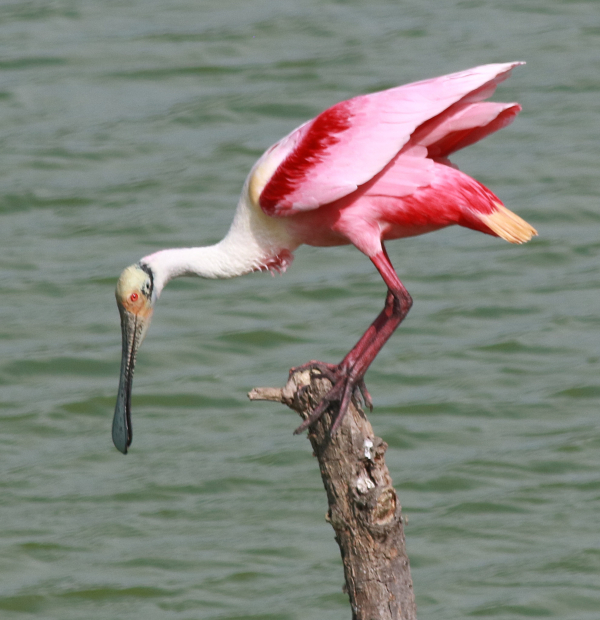
A perching spoonbill shows some vibrant shades of color after landing that are usually covered during bouts of standing, perching, walking, or wading.
On the photo tech side of things, I was using my regular middle of the road f-8 aperture, which yielded fast shutter speeds ranging from 1/1250 to 1/2000 get sharp images of the eyes, wings, and other features of the birds in flight. As always, I had the continuous photo setting dialed in, which allowed me to take a burst of photos when I wanted to, but I found myself almost always taking 1 or 2 images at a time, and enjoying that more than rat-a-tat-tat-ta-tat photography that some photographers were prone to do. Even so, it was great fun to interact a little with other photographers, check out their equipment, and hear their impressions of this fantastic photo location. Similarly, it was wonderful to hear reactions from a parade of other birders and interested people, especially those who were visiting the area for the first time. Families were the best of all, especially those with young children who took immediate interests in the remarkable avian activities before them.
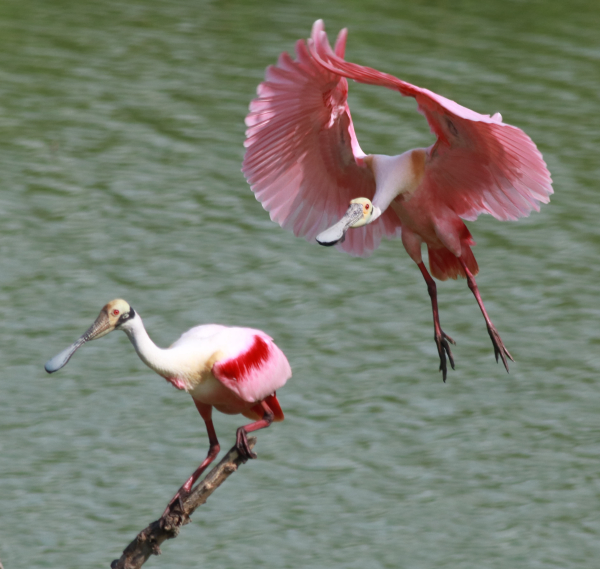
It seemed there was no end to the potential flight photos the big pink birds would provide. The f8 aperture provided ample depth of field to get both birds within the focal zone at a distance, and the shutter speed of 1/1250 provided an excellent action-stopping image.
Rookery Flights
After the second day of beautiful afternoon light and almost constant action last Sunday, I caught myself wondering if I was enjoying too much of a good thing; would I eventually tire of it? (Didn’t happen.) The Roseate Spoonbill flights were epic, and I must have photographed the big pink birds from every conceivable angle. I definitely gave my 400mm f5.6 lens a workout, especially the autofocus, which worked as best it could under the fast-paced circumstances at varied distances. The birds were mostly flying left to right or right to left in front of me, although they also approached from one side or the other at a variety of angles, plus head-on and going away.
Many of these flights were at pretty quick speeds, and I liked to follow their flights to get just the right angle of the bird, and to get the unbroken water or sky as the background. That’s when the need to follow the birds’ flight through my camera lens and anticipate their wingbeats or gliding flight was important as I took individual photos or short bursts of 2 or 3 photos. My favorite flights were when the birds circled or flew in a half-circle, banking one way or another; those flights provided enjoyable chances to take a series of photos at a bit slower flight speeds. Similarly, it was fun to photograph birds as they were landing with their wings and tail spread, especially from the side or front. Overall, it was a great opportunity to get a lot of practice photographing birds in flight in during a short period of time. Two hours provided what must have been a year’s worth of photography experience, so each afternoon my reactions and follow-through improved exponentially, while yielding some exceptional photos and thrills.
All this while using and appreciating the value of the elevated platform at the east end of the Canopy Walkway. I was holding my camera about 20 feet above ground level, and that provided some especially impressive photo angles – most of which just aren’t possible when photographing from ground level, where you are often photographing upward into the shadowed underside of the birds. From the Canopy Walkway, most birds are flying at your level, or even below you, which provides a great perspective for viewing and photographing, and it allows you to take advantage of the light from above when the sun is higher in the sky.

The pink really comes through in this close-focus image that shows the details of the spoonbill’s head, neck, and bill.
The Exceptional Skyway
Realistically, the elevated Canopy Walkway adds so much to the High Island photo experience, and the action at the rookery is just one aspect of this remarkable construction, which also provides close access to the mid-story and upper reaches of the beautiful trees that will fill with songbirds in coming days and weeks. I had a quick introduction to this aspect of “skyway bird photography” Saturday afternoon, when a collection of warblers attracted my attention. In a very small area of the mid-section of a beautiful tree I was able to identify a Yellow-throated Warbler, a Northern Parula, and a Black-and-White Warbler – and get a representative photo of the Yellow-throat! How I wish I could be present for some of the fine songbird days to come.
But the wading birds are the great excitement now, and while the Canopy Walkway provides superb photo opportunities, Smith Oaks Sanctuary also provides a series of ground-level wooden platforms to view and photograph along the edge of the rookery, which is separated by a narrow water channel. There is another elevated platform a short distance from the skyway that positions you at the same level as the rookery birds’ activities, plus there are walking trails that parallel the rookery lake, and that meander through the property.
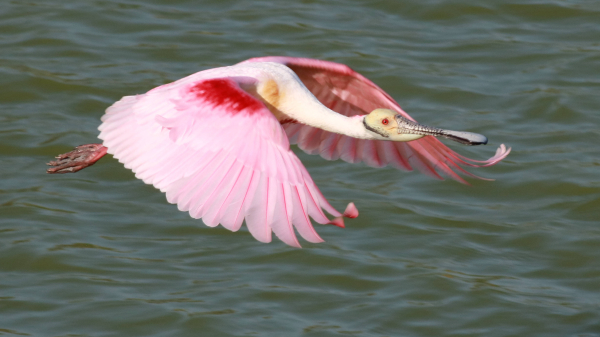
A favorite photo was produced as this Roseate Spoonbill took broad sweeping wingbeats as it prepared to land. The action at the High Island rookery was unmatched and provided a number of ultimate bird photography sessions.
All this and more is provided at the Smith Oaks Sanctuary on the edge of High Island, Texas, an hour or 2 southeast of Houston (depending on where you are coming from). Owned and managed by Houston Audubon, Smith Oaks is part of a series of wooded properties that includes the Boy Scout Woods Sanctuary, Eubanks Woods Sanctuary, and the S.E. Gast Red Bay Sanctuary – all in the village of High Island, less than a mile from the Gulf Coast. I can’t say enough about the quality of the birding locations Houston Audubon is providing, with the new Canopy Walkway an amazing new addition to the mix, now in its inaugural year.
With the Bolivar Peninsula stretching from High Island west to Galveston, Anahuac Refuge located to the northwest, plus McFadden Refuge and Sabine Pass to the east, this was a great location to spend my computer-based work period last week. It was a thrilling chance to explore some of the top birding locations in southeast Texas, among the best in the nation for birders interested in photographing a variety, and a wealth of birds. What more can you wish for when you need to charge up your pink power again?
Article and photographs by Paul Konrad
Share your bird photos and birding experiences at editorstbw2@gmail.com